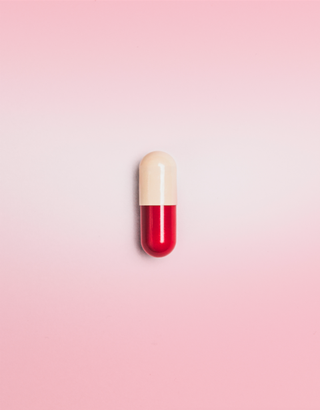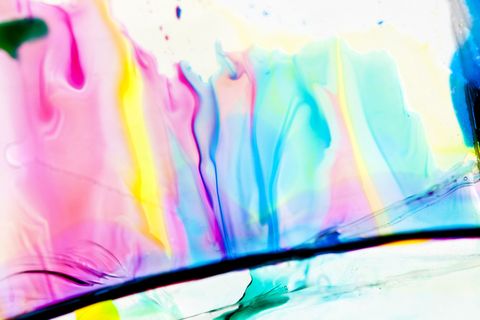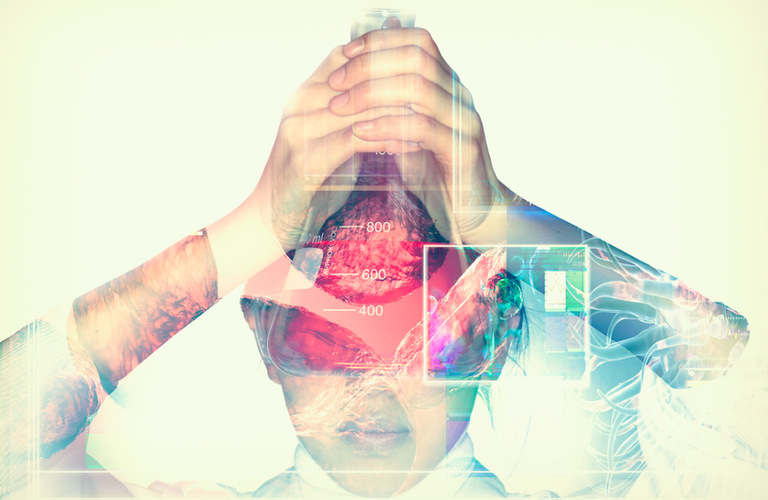Why Power Women Are Micro-Dosing LSD at Work
It's a different type of career high.

Karen Smith has a lot on her mind. The 32-year-old lives in Chicago, where, after working for tech startups abroad for 10 years, she moved last year with her husband to attend a graduate program in data science. On top of her academic studies, Smith works 10 to 30 hours a week as the data guru for a consulting firm. But late last year, what was really bringing her down was the bleak Midwest winters. That, and she'd recently cut out her daily habit of cigarettes and marijuana, frustrated that she'd become so dependent on pot to manage her mood. She needed something to take the edge off.
Smith—whose husband was also feeling low and looking for relief—had an idea, something she'd run across on Reddit. After some research, her husband bought psilocybin (psychedelic) mushrooms from a friend, ground them up with a Cuisinart spice grinder, and separated them into gel capsules ordered from Amazon. The dosage was precisely measured and precisely tiny: 10 micrograms for Smith's husband and about half of that for her, which is just below the threshold of what would normally make a user "trip." She took the homemade pill with a glass of water and waited. A few days later, she swallowed another one.

For the rest of the winter and into the spring, Smith (not her real name—she's concerned that the illegality of her self-medication could compromise her career) and her husband continued to take tiny doses of magic mushrooms every few days while going about their daily lives. Smith didn't see swirling wild colors or shifting shapes. She didn't feel as if the trees and sky were sparkling magically at her. She didn't imagine that she saw God. Instead—along with shaking off those winter blues—she became very, very efficient. "It gives you fresh eyes," she says, "for programming or figuring out algorithmic stuff. It made me really productive in a motivated way. Whatever mental block that was stopping me from doing something would disappear." Plus, during her four-month-long mushroom experiment, she got a lot of household chores done.
The term for what Smith and her husband were trying is "micro-dosing," a growing trend in psychotropic experimentation. Unlike other trending hallucinogenic experiences, like, say, drinking ayahuasca (a psychedelic tea brewed from Amazonian plants, sipped under the supervision of a shaman), micro-dosing doesn't deliver an earth-shattering, body-wrenching, mind-blowing journey through the other side of the Doors of Perception. The idea is to change, in an almost imperceptible way, your everyday neural functioning for the better.
"Smith didn't see swirling wild colors or shifting shapes. She didn't imagine that she saw God. Instead—along with shaking off those winter blues—she became very, very efficient."
While it's impossible to gather hard data on micro-dosing, anecdotal evidence suggests that its use is on the rise: The popular podcast Reply All devoted a segment to it last fall; Rolling Stone, VICE, and Forbes chronicled it as a trend shortly afterward; and one YouTube how-to tutorial has been streamed more than half a million times since it was posted in September 2015. Reddit, where Smith picked up the idea, has an entire subReddit devoted to the topic with more than 9,000 subscribers. Tech insiders in particular seem eager to try it out as an alternative to Adderall (the prescription stimulant, prescribed to treat ADD/ADHD, that helps users stay motivated and on task, but may cause irritability and anxiety)—one that helps not just with efficacy and focus, but also with creativity. The women who try micro-dosing aren't burnouts; in fact, the ones we spoke to are high-achieving, and interested in becoming more so.
Women like New York Times best-selling author Ayelet Waldman. The writer and former drug-policy lawyer (and wife of author Michael Chabon) suffered for years from PMDD (premenstrual dysphoric disorder), a severe form of PMS that mimics depression, which she was treating with SSRIs (antidepressants) timed to the week before her period. But when the Berkeley, California-based Waldman, 52, hit perimenopause, her periods became far less predictable, and she began to hunt around for other options to manage her moods, which is how she began micro-dosing as a one-month experiment, despite her self-confessed aversion to drugs of that sort.
"I thought if there was one human being in the world destined to have a bad trip, it was Ayelet Waldman," she says. "I mean, I could have a bad trip over breakfast. I don't need a drug for that." But she'd begun to realize that the legal drugs she'd been prescribed for years had plenty of drawbacks: "There was a study published about Ambien and Alzheimer's long after I'd taken a thousand Ambien."
Get exclusive access to fashion and beauty trends, hot-off-the-press celebrity news, and more.

Before trying her experiment, Waldman conducted extensive research into the myths and realities surrounding LSD. (Perhaps the most encouraging fact of all: "LSD is, as drugs go, safe. In terms of morbidity, it's a lot more like marijuana than heroin," according to her research.) She also corresponded with Menlo Park, California-based psychologist James Fadiman, Ph.D., whose chapter on micro-dosing in his 2011 underground classic, The Psychedelic Explorer's Guide, meant to be a practical guide to psychedelics, introduced the term to the mainstream of drug culture (if not yet the mainstream itself). Fadiman explained exactly how to microdose and how he developed his method. Waldman was thrilled with the results: She regulated her own moods better and worked through marital bumps more easily. Her children—whom she told only that she was trying a new medication—gave her experiment glowing reviews. "I didn't fly off the handle as much," she says. "I wrote a whole book called Bad Mother [which was published in May 2009]. If I had been micro-dosing back then, I probably would have written Remarkably Calm, Compassionate Mother."
What really surprised Waldman was the way it affected her work. "I found it inspired a state of calm hypomania. It was a flow but without the Adderall irritability. You lose track of time because you're so into the work, and you're making all these exciting connections." Most tellingly, says Waldman, is that, "I wrote a book in a month!" She turned her journal and research on micro-dosing into A Really Good Day: How Microdosing Made a Mega Difference in My Mood, My Marriage, and My Life (which will be published in January by Knopf ).
The idea of taking a psychedelic multiple times a week might seem impossibly risky to those of us who were raised with stories of 1960s-era acidheads who died thinking they could fly off tall buildings, or hearing the cafeteria shibboleth that if you took more than seven LSD trips in your life, you'd become legally insane—but the concept of micro-dosing has actually been around for a long time. Albert Hofmann, Ph.D., the Swiss chemist who first synthesized LSD in 1938 and died in 2008 at the age of 102, actually microdosed his own invention for decades at the end of his life, as reported in Waldman's upcoming book.
"I wrote a whole book called 'Bad Mother.' If I had been micro-dosing back then, I probably would have written 'Remarkably Calm, Compassionate Mother.'"
Fadiman began research on LSD in the early 1960s at a research lab in Menlo Park. This was before the drug was banned in the United States after the Staggers-Dodd Bill was passed in October 1968, and before the Summer of Love cemented it in the popular imagination not as a tool for enhancing the mind (as Fadiman saw it), but for "dropping out" (in the famous phrase of Timothy Leary, the rogue Harvard University researcher whom President Richard Nixon once called the "most dangerous man in America" for his role in popularizing drugs). Nightmarish, albeit exaggerated, stories of LSD's effects had a chilling effect, even if they were later found to be mostly untrue. As a January 26, 1968, Time magazine article begins, "There is no doubt that LSD can have severe and harmful effects on the minds of those who take it." The article goes on to describe a story that circulated about how a group of undergraduates in Pennsylvania, who took LSD while lazing around the university's grounds, stared "wide-eyed into the sun" for hours, burning their retinas so badly that they went blind. It turns out the commissioner of the Office for the Blind in the state's Department of Public Welfare "fabricated the story to drive home the dangers of LSD."
But that hasn't stopped Fadiman, who, a few years ago, began collecting self-reported experiences by a small number of users, looking for patterns. Fadiman offered a simple protocol for users to follow: One day of micro-dosing (at the 10-microgram level) followed by a couple days off, which would be a baseline of normal brain functioning against which users could measure their experience. (Many users reported the second day as their happiest, most productive day.) He encouraged microdosers to carefully track their moods and any physical reactions to the drug. On the fourth day, the cycle started over again. The side effects? The one that seems to have intrigued modern experimenters like Smith and Waldman is a state of flow: highly concentrated, almost joyful, productivity. Microdosing, as Fadiman explains in his book, is also said by some to "cure" cluster headaches, anxiety, and depression, the last being one of the most popular reasons why people turn to microdosing and its mood-balancing effects.
Dr. Molly Maloof, a physician in San Francisco whose patient base consists of hard-charging tech executives, says there's already a culture in the tech industry of trying to optimize one's brain, whether through legal methods like sleep tracking or obsessive nutritional tweaking, or through the less wholesome options of pills and powders. "It's like Valley of the Dolls, but it's Silicon Valley of the Dolls," she says, citing the widespread off-prescription use of Ritalin (prescribed to treat ADHD), Adderall, and Modafinil, a narcolepsy aid. The number of friends and patients asking Maloof about micro-dosing is, in comparison to Modafinil, quite small, but she has noticed a pronounced uptick in outside interest over the past year. For Fadiman, the volume of e-mail he's received from the microdose-curious (and data from users) has accelerated dramatically of late.

"It's an ongoing exploration on my part," says Katherine Dean, 26, a microdoser who up until recently worked in sales for a marketing startup in San Francisco. Dean (also not her real name) is a "biohacker"—one who "hacks" their biology by self-collecting data via methods such as DNA, blood, and adrenal testing to determine which dietary modifications (like drinking "bulletproof coffee": coffee blended with grass-fed unsalted butter and Brain Octane Oil), supplements (like nootropics), and technologies (like a headband that electrically stimulates neurons for better cognition) to implement to improve functioning. There are labs, meet-ups, and conferences around the globe where community members discuss methodologies and discoveries. As 2016 dawned, Dean decided she wanted to work on her relationships with other people. Microdosing, she'd heard from other biohackers, is said to bring out empathy. She kept a diary of her experience, with entries like "warm in stomach now" and "a little clumsy while making [food]." She made lists of pros—"increased extroversion," "elevated mood"—and cons. At least initially, Dean felt she wasn't as good at motor-skills tasks, and (unlike others) thought it decreased focus.
Many drugs, both legal and illegal, make you feel better, for varying amounts of time, some by tweaking levels of serotonin, the mood-regulating neurotransmitter (or brain chemical). SSRIs make more serotonin available for use by your brain in a controlled way. MDMA, also known as ecstasy, and cocaine also flood the system with serotonin (and dopamine, a neurotransmitter that helps control the brain's pleasure center), which is why users feel fantastic when they're high and often deeply bleak the next day: They've gotten an advance on their happiness paycheck. Psychedelics work on some of the same receptors in the brain that moderate serotonin, but they're doing a different kind of work. They increase glutamate, a neurotransmitter that enables cognition. When people say these drugs expand your mind, they're actually being quite literal. But not as much is understood, on a clinical level, about how psychedelics affect neurological functioning because so much depends on mood and individual brain chemistry.
While Dean didn't experience the miracle of hyper-focus, micro-dosing did help her at work. Dean made 120 sales calls per day pitching her company's software to small businesses, and at least eight of those calls needed to result in sales. After micro-dosing, she says, she nailed an average of one to two more sales per day. Dean says that the mushrooms helped her switch personas as needed—without consciously realizing it, she became girlier and sweeter when trying to sell to an older man, for instance. "When I'm micro-dosing, I'm more creative," she explains. "I read people better. It gives me a broader range of compatibility." She isn't shy about her habit: Her friends knew; her coworkers knew; even her mother knew. The only significant person in her life Dean hadn't shared with was her boss at the time. A smart move, perhaps—just ask the 20-something programmer for a San Francisco tech company who was fired for micro-dosing after bragging about her self-medication to coworkers and even over company e-mail.

Is this really the miracle drug that will fix moods, increase productivity, boost creativity and empathy—all without the risk of addiction posed by its prescrip- tion counterparts? Hard to say. After a decades-long drought in clinical research, there have been a few scattered studies, at UCLA, NYU, and Johns Hopkins, and in Switzerland, on the use of psychedelics in patients facing the end of life, for instance. (Results from the UCLA study suggest it can help profoundly ease existential anxiety.) But formal work on micro-dosing psychedelics is virtually nonexistent.
Maloof decided micro-dosing wasn't for her, as she already "wakes up with so much vitality every day" and worries about the necessarily ad hoc nature of dosage measuring. Because LSD is illegal, she notes, there are no clinical trials to determine dosing based on gender, weight, brain chemistry, and so forth, nor can you count on knowing exactly how any batch you're sold will affect you.
"Micro-dosing is also said by some to 'cure' cluster headaches, anxiety, and depression, the last being one of the most popular reasons why people turn to micro-dosing and its mood-balancing effects."
The National Institute on Drug Abuse (NIDA) warns that little is known about the long-term effects of psychedelic use at any dosage level; some users with a preexisting condition have had seizures triggered by larger doses. Matthew W. Johnson, a researcher who specializes in psychedelics at Johns Hopkins School of Medicine (and who is generally excited about the potential medical and therapeutic uses of them), says, "Classic psychedelics are not addictive at all," but urges caution, given the lack of research and the unregulated nature of the drugs. He emphasizes that people can take what they think to be a microdose and be hit with a much stronger effect than they'd bargained for. As with any street drug, it's difficult to determine the purity of the substance (LSD in particular can be laced with things like PCP or cocaine). Consider this scenario: You take what you assume is a microdose, walk into work, and start tripping at your desk or in a meeting. And whether you're experiencing superhuman focus or seeing the world through a kaleidoscope, your judgment is altered, at least temporarily, when taking the drug. "People talk about micro-dosing in your everyday life," he says, "and that includes driving or making decisions at work." The implication: It's a risk. That and "We just don't know about the benefits," he says. "They're possible, but I'm not convinced by anything. Micro-dosing seems really ripe for a placebo effect."
The NIDA also notes, on its Web page for hallucinogens and dissociative drugs (like PCP and ketamine), that in the rare instances when large doses of hallucinogens trigger prolonged episodes of psychosis or flashbacks, it's "often...in individuals with a history of psychological problems" or a family history of schizophrenia and related diseases. Johnson agrees. "It seems convincing that people who have a psychotic predisposition are harmed by them," he says. "If your concept of reality is hanging by a thread, the last thing you need is a high dose of a psychedelic. In terms of lower doses, it's anybody's guess."
The question of how long to microdose is an open one, too; Fadiman doesn't encourage users to be on the protocol indefinitely. Waldman stopped after her one-month experiment, in part because she didn't trust street drugs, and makes an argument in her book that micro-dosing will only be truly understood when LSD is decriminalized and can be clinically studied and legally regulated. "I stopped micro-dosing because it's illegal," she says. "If it were legal, I would have continued." Smith stopped when she started trying to get pregnant, though she says she'd try again when her body "is my own" again. Dean is still micro-dosing. She's still learning things about herself through the protocol, and quotes the philosopher Alan Watts, who had a simple recommendation for knowing when to stop using psychedelics: "When you get the message, it's time to hang up the phone."
This article appears in the December issue of Marie Claire, on newsstands now.